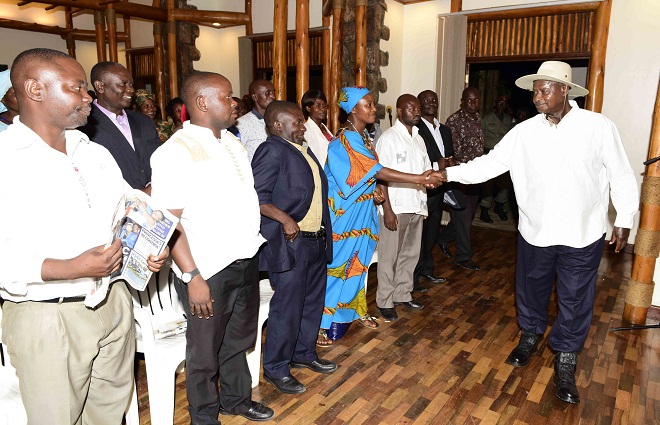
Kasese erupts
After the meetings in Bundibugyo, Museveni headed to Kasese district. Over the weekend of April 9 and 10 he met with leaders in Kasese, including opposition leaders from Kasese led by the Woman MP Winnie Kiiza (FDC) at Mweya Safari Lodge.
Kasese voted overwhelming for the opposition and is, therefore, seen as `enemy territory’ by the government. In the medley of such politics and ethnicity, one must add the history of armed conflict stretching to the 1960s Rwenzururu movement and false beliefs that fetishes can save fighters from bullets. The conflict in Kasese is, therefore, more complex.
Museveni is keenly aware that his National Resistance Army (NRA) and armies that have fought him, like the National Army for the Liberation of Uganda (NALU) and the Allied Democratic Forces (ADF) have all had bases in the Rwenzori Mountains. Some people working as Rwenzururu traditional royal guards are veterans of these battles. Add this to the age-old tension between the Bakonzo and Basongora over access to land in the lowlands and you have a keg of dynamite waiting to explode.
The Bakonzo, who live in the mountains, are the majority. They have often sparked conflict with moves to cultivate the lowlands occupied by the Basongora. The conflict has was, however, intensified as far back as 1925 when the colonial British administrators created the Lake George Game Reserve and later the Kazinga National Park in 1952 – later re-named Queen Elizabeth National park in 1954. All these allegedly led to dispossession of the Basongora of their land.
The Basongora also claim their grazing plains were taken by the Mubuku Irrigation Scheme (2,000 acres), Mubuku prison farm (7,550 acres), Forestry department (8,400 acres), Hima UPDF production farm (6,597 acres) and Ibuga Prison farm (3000 acres), among others. In 2011, the central government proposed a land sharing deal between the Bakonzo and Basongora on a ratio of 1:3. But the Bakonzo who were to benefit from this land feel the distribution ratio was unfair.
The recent killings in Kasese were at first tagged to post-election violence at Hima where a dispute over the LC3 chairman election turned bloody. But what surprised many was why five people were shot in cold blood by police and UPDF soldiers in Buhuhira subcountry, which is 30km from Hima town. According to eye witnesses the police being commanded by the Police’s Field Force Unit Jacob Opolot were being directed by a Gombolola (sub-county) Internal Security Officer (GISO) to shoot people. The confused civilians began pelting them with stones and other objects. The security forces shot four civilians dead. It later emerged that the GISO had a conflict with some people in that village and was settling scores.
Most of the people who died were traditional royal guards who volunteer to guard Omusinga Charles Mumbere. More royal guards were killed later in Kasese. These royal guards are in every sub-county where people pay allegiance to Obusinga.
In a surprise twist, the Inspector General of Police; Edward Kale Kayihura, accused th e royal guards of Omusinga of leading attacks on government security positions. The Obusinga (kingdom) denied the accusations.
Prior to these killings in Kasese, the outgoing Member of Parliament for Busongora South Boaz Kafuda (who was defeated in the recent parliamentary elections) had led a delegation of Basongora, Bakingwe and Banyabindi of Kasese to state House Entebbe and met President Museveni. Kafuda’s delegation which included the Kasese RDC, Maj. James Mwesigye, reportedly told Museveni that the minority ethnic groups were marginalised in Kasese by the majority Bakonzo and that the Bakonzo were planning to secede from Uganda to form a “Yiira” state with their counterparts in DR Congo. Kayihura appears to have bought that line.
But when you talk people in Kasese, the majority says they are hearing of the Yiira state for the first time. Apparently, the Yiira claim is bandied around each time there is killing of people in Kasese. It was the same excuse that was given when the July 5, 2014 attacks happened in Rwenzori.
Charles Wesley Mumbere Iremangoma, the Omusinga (king) of Rwenzururu has said those claiming that the Bakonzo are fighting for a state that is independent of Uganda are enemies of his kingdom.
“If I was fighting for a state, would I be living in Kasese today? Those spreading the lies of creating a state in Rwenzori are enemies, they want to destroy our relationship with the central government,” Omusinga said. But that is not to say that the Bakonzo do not speak of forming a state in Rwenzori. It was at one time a vision behind the Rwenzururu Movement led by Isaya Mukirania and later their current king, Wesley Mumbere. Rwenzururu Freedom Movement was a protest against Toro kingdom’s marginalization of the Bakonzo and Bamba. Because the Rwenzururu fighters had become a menace to the colonial and post-colonial governments, Obote II government negotiated peaceful settlement in 1982.
 The Independent Uganda: You get the Truth we Pay the Price
The Independent Uganda: You get the Truth we Pay the Price



